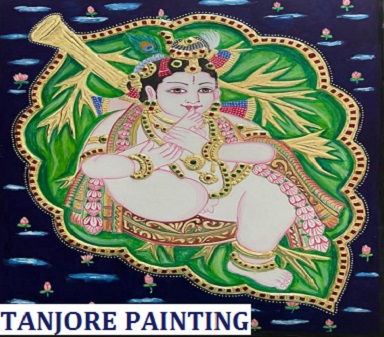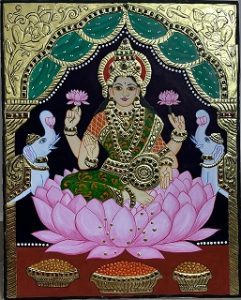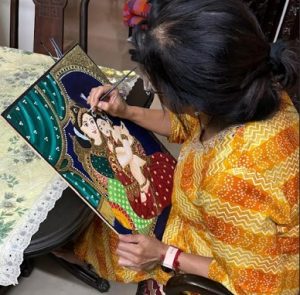SIGN UP FOR NEWSLETTER
Be the First to Know. Sign up to newsletter today

Tanjore painting is one of the most popular and refined classical paintings from South India. The painting is native to Thanjavur or Tanjore, a city in the State of Tamil Nadu. As a matter of fact, it originated under the rule of Marathas in the 16th century.
Tanjore,is famous for the the Brihadeshwara Temple built during the Chola reign in the 11th Century. The Tanjore painting is the craft shaped by the painters from Vijayanagar empire who migrated to Tanjore. Tanjore was under the rule of the Nayaks and the Maratha rulers then.
Available at Chennai:- VTI, Poompuhar, Srushti The Handicrafts Emporium, Rasi Silks
Shops in Delhi:- Central Cottage Industries, Poompuhar
Available at Pondicherry:- Amarane Art Gallery
A typical Tanjore painting is principally inspired by religion and centers around Hindu gods and goddesses.Hence you would find paintings of Krishna & Radha, Lord Rama, goddess Saraswati & so on.The concentrated composition, the use of gold foil and semi-precious coloured stones in the painting is very distinctive.
An introductory sketch of the image is drawn on a canvas or paper and is one of the first steps in the making of a Tanjore Painting. For example, the paper is pasted over a wooden base. Later, chalk powder or zinc oxide is mingled with water-soluble adhesive and applied on the base. In other words, gesso, is a glue that is applied on the painting to hold the stones and gold foil in place.Further, the drawing is embellished with semi-precious coloured stones. The coloured stones are placed on the painting one by one. Subsequently, the gold foil is cut into small squares and stuck on all the empty spaces. It is a time consuming process. 22k Gold foil has to be procured from an authentic jeweller. The gem stones are normally procured from Jaipur.
Artists predominantly use dark brown for outlines. However, as a traditional practice, a dark blue colour is employed as the background colour. Red is used at the bottom . These are traditional colours that highlight the gold coloured portrait.
Similar to Tanjore painting is Mysore painting . 24k Gold is used in Mysore painting and there are no semi precious coloured stones on it. Hence,it is more gold work & colours that would be visible in the painting.Further, the artists concentrate on drawing out expressive eyes.The gold foil is used to embellish and highlight the designs. Tanjore painting & Mysore Painting requires a lot of effort and there is intensive work involved.
Contact Ms. Shanthi for Tanjore Paintings
Mobile No :- 91 755 804 4728
Her Paintings:



Be the First to Know. Sign up to newsletter today
344 views